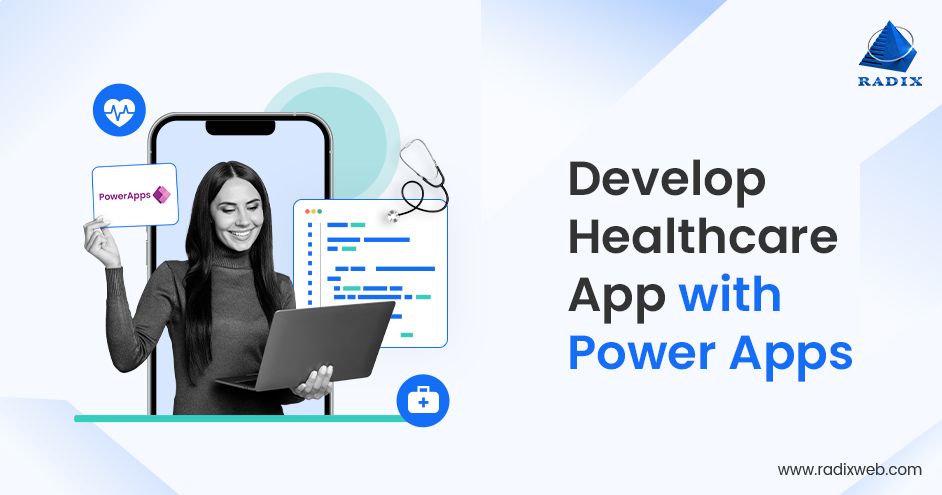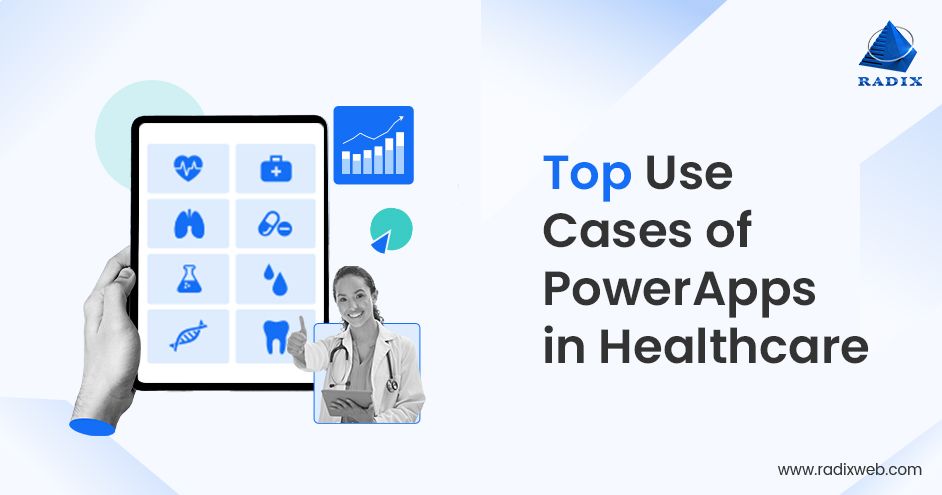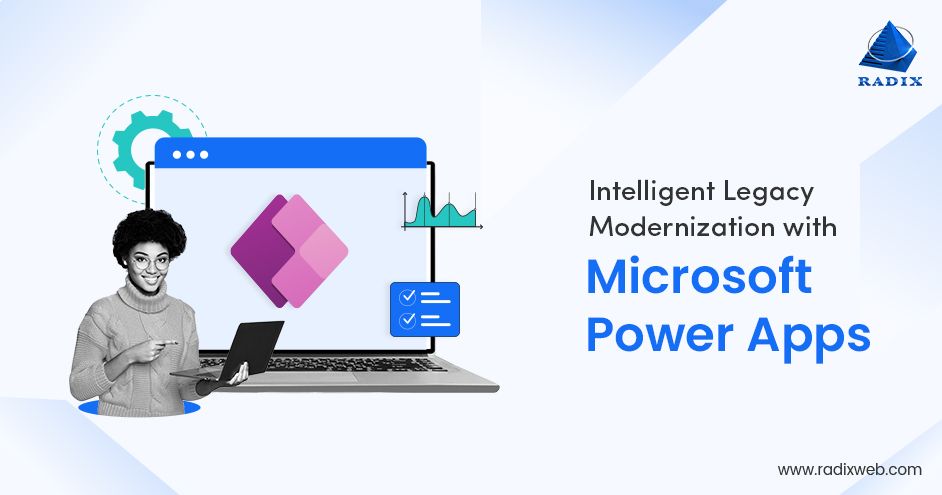Read More

Skip Setup Headaches and Start Your Project Fast - Download Free Boilerplates
ON THIS PAGE
Quick Overview: What if developing a secure, data-driven business website didn’t take months of coding or a full-stack team? With Microsoft Power Pages, that idea is now a reality. This blog dives into how the Power Pages helps organizations cut development time, lower costs, and launch enterprise-grade portals faster. Let’s explore its core capabilities, real-world use cases, and key planning insights for successful deployment.
Every day there’s mainly one question raised by businesses: how to build a better, faster, and smoother digital experience without breaking the budget?
Customers want to experience seamless self-service portals, partners ask for real-time access to data, and employees want tools that just work. Yet traditional web development often means long timelines, complex integrations, and heavy maintenance costs.
That’s why many CIOs and enterprise owners are moving towards Microsoft Power Pages, a low-code platform built to simplify and accelerate web development. Instead of writing thousands of lines of code, teams can design, connect, and launch secure, data-driven websites through an intuitive drag-and-drop interface.
Power Pages is a combination of low-code design with the reliability of Microsoft’s enterprise ecosystem. Hence, it gives businesses a faster route from idea to implementation.
What makes Power Pages stand out isn’t just convenience. It’s the real impact on development time, cost, and productivity. From reusable templates and prebuilt components to integrated hosting and governance, every feature is designed to reduce effort.
This article explains how Power Pages reduces development time and cost, the technical mechanics behind it, and what business leaders should know before adoption.
What is Microsoft Power Pages?
Microsoft Power Pages is a low-code platform for creating secure, responsive, and scalable external-facing websites. It connects directly to Microsoft Dataverse, integrates easily with Power Automate, Power Apps, and Power BI, and supports enterprise-grade governance.
As a standalone SaaS solution, Power Pages delivers enterprise-grade hosting, built-in security, and scalability on the Power Apps infrastructure. For professional developers, it integrates with GitHub, Visual Studio Code, Power Platform CLI, and Azure DevOps. This enables advanced customization, automation, and CI/CD workflows.
Recently, Microsoft introduced Power Pages Copilot, an AI-driven assistant that takes low-code development even further. Instead of relying solely on drag-and-drop tools, users can now build websites through natural language prompts. Copilot can generate text, create detailed forms, and even configure chatbots. Also, it helps you streamline the entire process of building data-centric business websites.
Core Capabilities of Microsoft Power Pages
Microsoft Power Pages simplifies the web development process while maintaining enterprise-level performance, security, and scalability. Let’s read some of the major Power Pages capabilities that make it a powerful choice for web development.
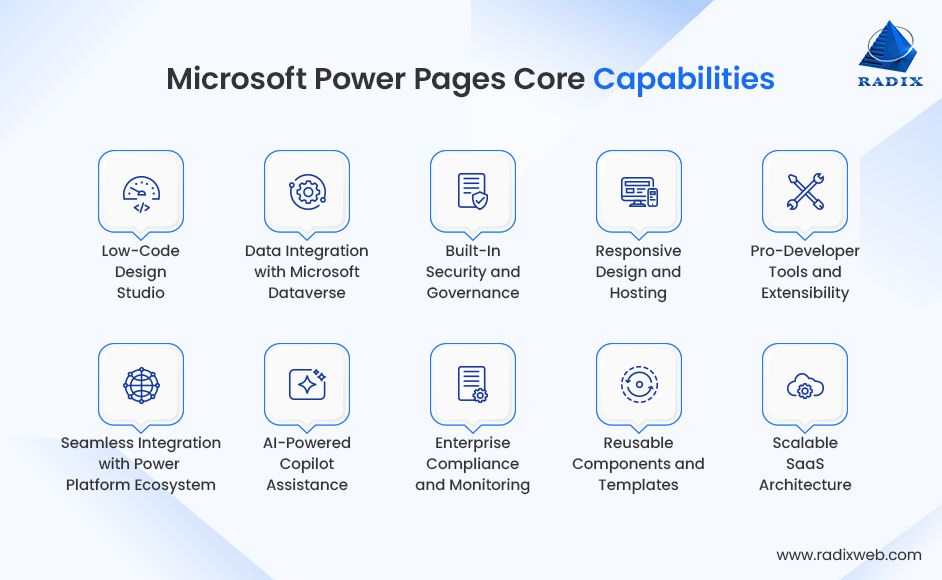
Low-Code Design Studio
The Design Studio is the heart of Power Pages. It comes with an intuitive drag-and-drop interface for creating responsive web pages, forms, and layouts. Its main advantage is that it enables this functionality without writing extensive code.
It also allows users to visually edit pages, style components, and preview changes in real time. Moreover, prebuilt Power Pages templates, themes, and section layouts help teams start faster and maintain brand consistency.
Data Integration with Microsoft Dataverse
Power Pages connects natively to Microsoft Dataverse, the shared data platform across the Power Platform ecosystem. This allows seamless access to business data stored in Power Apps, Dynamics 365, or other integrated systems.
This allows developers to define data tables, relationships, and permissions. It also ensures that website content remains accurate, secure, and synchronized.
Built-In Security and Governance
Microsoft Power Pages ensures security at every layer of applications. The platform supports role-based access control, Azure Active Directory (Azure AD) authentication, and integration with Microsoft Entra for external user management.
Admins can set permissions for authenticated and anonymous users, enforce data policies, and maintain compliance with enterprise governance standards.
Responsive Design and Hosting
Power Pages-built websites are automatically responsive for desktops, tablets, and mobile devices. The hosting infrastructure is managed by Microsoft and powered by Azure, ensuring enterprise-grade performance, availability, and global reach.
This means no manual server management, SSL setup, or load balancing. You can see, everything is handled by the platform.
Pro-Developer Tools and Extensibility
We all know that Power Pages takes advantage of low-code/no-code development, offering full support for professional developers. It helps you to integrate with GitHub, Visual Studio Code, Power Platform CLI, and Azure DevOps. Also, it enables you to source control, environment management, and automated CI/CD pipelines.
Furthermore, developers can extend functionality with custom HTML, CSS, JavaScript, and Liquid templates. This gives them flexibility to meet complex business requirements.
Seamless Integration with Power Platform Ecosystem
You can easily connect Power Pages natively with Power Automate for workflow automation and Power BI for embedding analytics dashboards into portals. This unified ecosystem allows businesses to collect data through Power Pages, process it via automated flows, and visualize insights instantly.
AI-Powered Copilot Assistance
The latest addition, Power Pages Copilot, introduces conversational AI to website creation. Users can easily describe in simple language what they want. For example, “Create a registration form with name, email, and approval workflow”. And here we go. Copilot generates it automatically.
It can also assist with content writing, chatbot configuration, and layout suggestions, speeding up development even for non-technical users.
Enterprise Compliance and Monitoring
Power Pages adheres to Microsoft’s compliance framework, supporting GDPR, HIPAA, and other global standards. Built-in monitoring, logging, and analytics tools allow administrators to track performance and security in real time.
Reusable Components and Templates
Power Pages encourages modular development through reusable design patterns, themes, and data components. This helps developers save and repurpose templates for future projects. As a result, it enhances delivery while ensuring design consistency across the organization.
Scalable SaaS Architecture
Built on the Microsoft Power Platform infrastructure, Power Pages offers built-in scalability. As traffic or data volume increases, the platform automatically scales resources without manual intervention.
How Power Pages Reduces Development Time
Complex coding, manual integrations, and lengthy testing cycles often result in slow business-ready web solutions. Microsoft Power Pages addresses these bottlenecks through automation, low code tools, and built-in infrastructure support.
Let’s go through some factors in how Power Pages saves development time.
Low-Code Development Environment
The Design Studio in Power Pages eliminates the need to hand-code every page component. Developers and business users can design pages visually using drag-and-drop sections, forms, and layout templates.
- What happens: The Design Studio automatically generates underlying HTML, CSS, and Liquid code that defines the site’s structure and data connections.
- Result: Teams can move from wireframe to functional prototype in hours instead of days.
- Example: Creating a registration form or contact workflow no longer requires writing form markup, validation logic, and data handlers. It’s configured visually and linked directly to Dataverse.
Prebuilt Templates and Data Components
Power Pages offers a library of industry-specific templates (for customer self-service, partner portals, or onboarding systems). These templates contain responsive layouts, navigation, forms, and data logic that are instantly deployable. Here, each template is built with reusable components that map directly to Dataverse tables.
Advantage: Developers can extend these templates by editing Liquid templates or adding JavaScript, without rebuilding from scratch.
Result: Time to initial deployment is reduced by up to 60% in early-stage projects, according to internal Microsoft data.
Native Integration with Dataverse
While going for traditional web app development, it often requires weeks to integrate with databases and APIs. On the other hand, Microsoft Power Pages skips this step by connecting natively to Microsoft Dataverse.
- How it works: Each form or table on the website maps to a Dataverse entity. When users submit data, it’s instantly stored and available across Power Apps, Dynamics 365, or Power BI.
- Security and logic: Access rules, data policies, and validation logic are defined in Dataverse once and applied everywhere — no need for duplicate code.
- Result: Backend integration and data synchronization tasks are reduced to simple configuration rather than full-stack development.
Automated Hosting and Deployment
Setting up infrastructure is one of the most time-consuming parts of web development. Power Pages removes this burden through managed Azure hosting and built-in CI/CD support.
- Automatic provisioning: When a site is created, Azure hosting, CDN distribution, SSL certificates, and DDoS protection are automatically configured.
- CI/CD support: Developers can integrate Power Pages with GitHub, Azure DevOps, or Power Platform CLI for version control, automated builds, and continuous deployment.
- Result: Instead of spending weeks on server setup and deployment pipelines, teams can launch directly from the Power Platform admin center.
Responsive Design Out-of-the-Box
Developing responsive front ends manually is a headache. Power Pages sites are automatically responsive, adapting to different screen sizes using a fluid grid layout system built into its design framework. It generates CSS Grid and Flexbox-based layouts dynamically when sections are edited in the Design Studio.
Result: No need for custom CSS breakpoints or separate mobile designs — saving 20–30% of front-end coding effort per project.
Empowering Citizen Developers
Non-technical staff like citizen developers can create and modify pages under IT supervision. This democratizes web creation, freeing skilled developers for more complex work.
How Power Pages Reduces Development Cost
Microsoft Power Pages delivers powerful web experiences while keeping budgets lean by streamlining how applications are designed, deployed, and managed. Here’s how Power Pages delivers measurable cost savings across the development lifecycle:
1. Elimination of Infrastructure and Hosting Expenses
Power Pages runs as a fully managed SaaS platform hosted on Microsoft Azure. That means businesses don’t need to invest in:
- Web servers, load balancers, or CDNs.
- SSL certificates or DDoS protection services.
- Maintenance of storage, scaling, or security infrastructure.
Business Impact:
Microsoft handles uptime, performance, and security. This helps you save both capital expenditure (CapEx) and ongoing operational costs (OpEx) associated with infrastructure management.
2. Reduced Developer and Resource Costs
Traditional web development relies heavily on specialized developers, from frontend engineers to backend architects. Power Pages minimizes that dependency through low-code visual design and reusable templates.
- Citizen developers can build and modify pages without deep coding expertise.
- IT teams can focus on high-value logic and integrations instead of repetitive UI tasks.
- Smaller development teams can manage more projects simultaneously.
Business Impact:
Organizations save significantly on labor costs while accelerating delivery. Forrester’s Total Economic Impact study reports up to 45% reduction in development effort when using Power Pages.
3. Lower Maintenance and Update Overhead
In traditional models, maintenance consumes a large portion of IT budgets. Power Pages drastically reduces this burden.
- Automatic updates keep environments secure and compliant.
- Visual design tools allow quick adjustments without recoding.
- Centralized Dataverse integration ensures data consistency across apps and portals.
Business Impact:
Maintenance overhead drops by up to 30–40%, and IT teams can reallocate time toward innovation instead of upkeep.
4. Reduced Integration and Development Complexity
Building a custom portal often involves connecting multiple systems, CRM, ERP, databases, and analytics. Power Pages minimizes this complexity through its native Dataverse and Power Platform connectors.
- Integrates seamlessly with Dynamics 365, Office 365, and Azure services.
- Reduces the need for third-party middleware or custom APIs.
- Ensures data consistency and reduces testing cycles.
Business Impact:
Less development complexity means fewer external dependencies, lower integration costs, and quicker deployment.
5. Faster Time-to-Market = Lower Opportunity Cost
The longer it takes to deploy a business portal, the higher the opportunity cost. Power Pages shortens delivery timelines with:
- Prebuilt industry templates and layouts.
- Seamless integration with Power Apps, Power Automate, and Power BI.
- Built-in security and governance, eliminating extra setup steps.
Business Impact:
By launching weeks or even months earlier, organizations realize ROI faster and reduce lost revenue opportunities tied to delayed releases.
Examples of How to Use Power Pages
Microsoft Power Pages offers flexibility to build a wide range of secure, data-driven web portals, from basic information sites to complex business applications.
Below are practical Power Pages examples, helping various teams to solve real business challenges efficiently.
Build a Customer Support Portal
Suppose you are a manufacturing company and want to enable customers to log service requests, track ticket status, and download product documentation without needing to contact support. In that case, Power Pages is the best option for you.
How Power Pages Helps:
- Use prebuilt Customer Self-Service templates to design the portal.
- Connect the portal to Dataverse or Dynamics 365 Customer Service to manage tickets automatically.
- Add Power Automate flows to notify service teams and send status updates to customers.
- Secure access with Azure AD or external authentication.
Result: Customers can manage their issues independently, reducing support costs and response time.
Create a Partner or Supplier Management Portal
If a retail brand wants to build a secure web portal where suppliers can update inventory, upload invoices, and track payments, Power Pages is a go-to solution.
How Power Pages Helps:
- Use Dataverse tables to store supplier and inventory data.
- Automate approvals and updates with Power Automate workflows.
- Allow authenticated partners to access their data through role-based permissions.
- Enable custom dashboards using Power BI for real-time order tracking.
Result: Partners can collaborate efficiently while the business gains real-time visibility across the supply chain.
Create an Internal HR Portal
A growing company needs a centralized portal for employees to submit leave requests, view policies, and complete onboarding forms.
How Power Pages Helps:
- Use internal authentication for employees via Azure AD.
- Build forms for leave and onboarding linked to Dataverse records.
- Use Power Automate to trigger approval flows for managers and HR.
- Enable analytics with Power BI to track usage and process efficiency.
Result: HR operations become faster, paperless, and more transparent. It saves administrative time and improves employee experience.
Develop a Data Portal with Power BI Integration
A logistics company can develop a dashboard for clients to visualize shipment status and performance metrics.
How Power Pages Helps:
- Build a portal with restricted client access through Azure AD.
- Integrate Power BI dashboards to display live data from Dataverse or SQL Server.
- Use Power Automate to refresh data and notify users of delivery updates.
Result: Clients gain a transparent view of operations, and the company improves service accountability.
Develop a Membership or Community Portal
A professional association wants a member-only site for profile management, payments, and event updates.
How Power Pages Helps:
- Configure user registration and authentication through Azure AD B2C.
- Build Dataverse tables for member data, subscriptions, and renewals.
- Add automated renewal notifications and receipts via Power Automate.
- Embed Power BI reports to track engagement metrics and membership growth.
Result: Members gain a modern digital experience, while administrators save time managing renewals and communications.
What to Plan Before Building with Power Pages
Before you go into web development, a successful Power Pages implementation requires detailed planning. While the platform simplifies web creation, effective results depend on clear architecture, governance, and integration strategy.
Here are the key areas every organization should evaluate before starting the Power Pages journey.
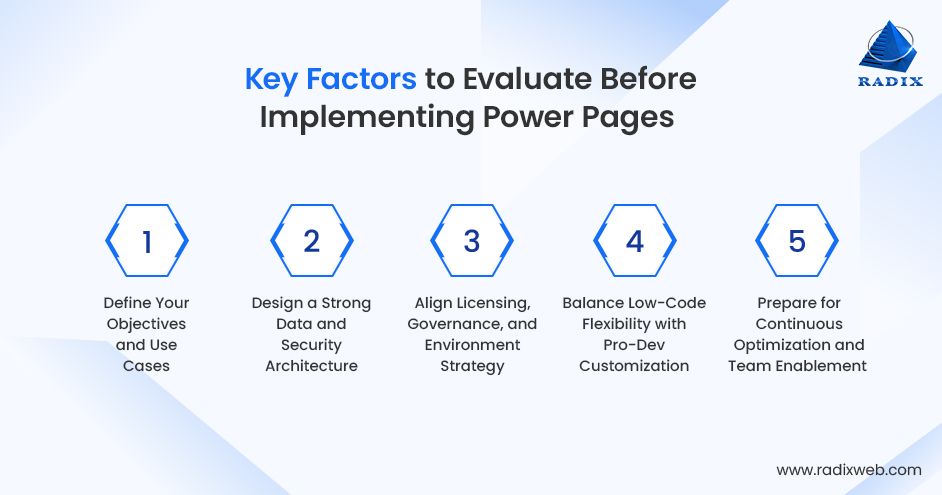
1. Define Your Objectives and Use Cases
First of all, identify what you want to build and why. Power Pages can serve customers, partners, or internal users. However, each use case has different technical and licensing needs.
- Find out specific goals (e.g., “Reduce customer ticket volume” or “Automate vendor onboarding”).
- Determine user types. Anonymous, authenticated, or internal staff.
- Prioritize MVP (Minimum Viable Product) features to ensure quick delivery.
2. Design a Strong Data and Security Architecture
Since Power Pages is built on Microsoft Dataverse, your data model and access control strategy determine both performance and compliance.
Plan:
- Map entities, relationships, and user roles early.
- Use Azure AD/Entra ID for authentication and apply role-based access in Dataverse.
- Ensure compliance with industry standards like GDPR or HIPAA.
- Limit API calls and enable caching for better response times.
3. Align Licensing, Governance, and Environment Strategy
Licensing, deployment environments, and governance are closely linked in Power Pages. Without proper planning, costs and complexity can rise quickly.
- Estimate user volumes to select the right licensing model (authenticated vs. anonymous).
- Separate development, testing, and production environments.
- Set up governance through a Power Platform Center of Excellence (CoE).
- Automate deployment using Azure DevOps or GitHub CI/CD pipelines.
4. Balance Low-Code Flexibility with Pro-Dev Customization
While Power Pages enables low-code creation, certain scenarios demand developer involvement for custom logic or unique UI elements.
- Identify where custom code (HTML, Liquid, JavaScript) is required.
- Use Visual Studio Code, Power Platform CLI, and GitHub for source control.
- Define collaboration between IT teams and business users from the start.
- Leverage Power Automate and Power BI to extend portal functionality.
5. Prepare for Continuous Optimization and Team Enablement
Power Pages projects don’t end at launch. Monitoring, analytics, and user empowerment leads to success.
- Train both developers and citizen users on Power Pages and Dataverse.
- Monitor usage and performance via Power Platform Admin Center and Application Insights.
- Use Power BI dashboards for analytics and feedback tracking.
- Regularly update templates and automation flows to match evolving business needs.
Radixweb: Your Trusted Partner for Power Platform SuccessLeveraging Microsoft Power Pages, or any other Power Platform consulting and Power Apps development is not just about building apps using a new tool. But it’s all about transforming how your business builds, deploys, and scales digital solutions.At Raidxweb, we help startup owners and enterprises unlock the full potential of low-code platforms by combining deep Microsoft expertise with a strategic Power Pages consulting approach.Our expert developers work closely with your team to design secure and data-driven Power Apps portals that reduce time-to-market and total cost of ownership. Whether you’re looking to modernize legacy systems, connect workflows across departments, or create customer-facing experiences, we ensure your Power Pages implementation aligns perfectly with business goals.Let’s transform ideas into intelligent web experiences. Partner with Radixweb to make your Power Pages vision a reality.
FAQs
How do Power Pages speed up website and portal development for businesses?
How do Power Pages help reduce overall development costs?
Can Power Pages integrate with existing business systems and data sources?
Are Power Pages suitable for both technical and non-technical teams?
What types of business applications benefit most from Power Pages?
How secure are websites and portals built on Power Pages?
How does using Power Pages improve ROI for organizations?
What industries can benefit most from adopting Power Pages?
Ready to brush up on something new? We've got more to read right this way.





